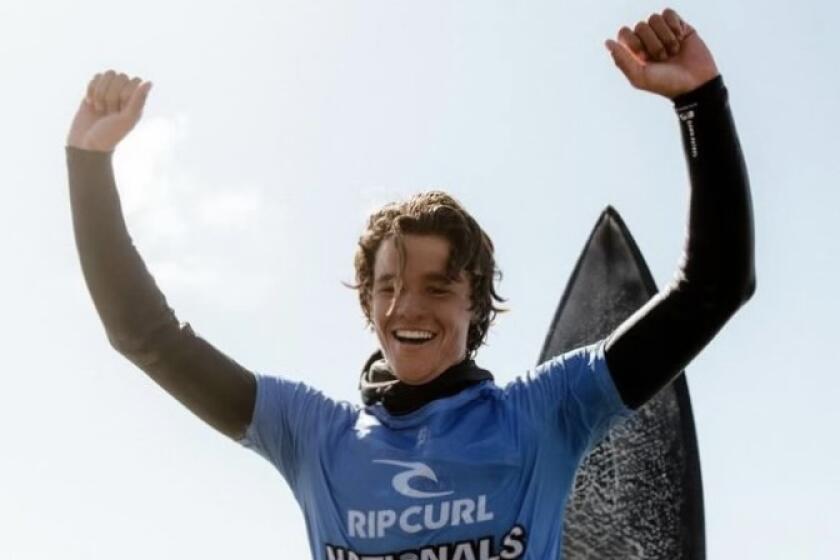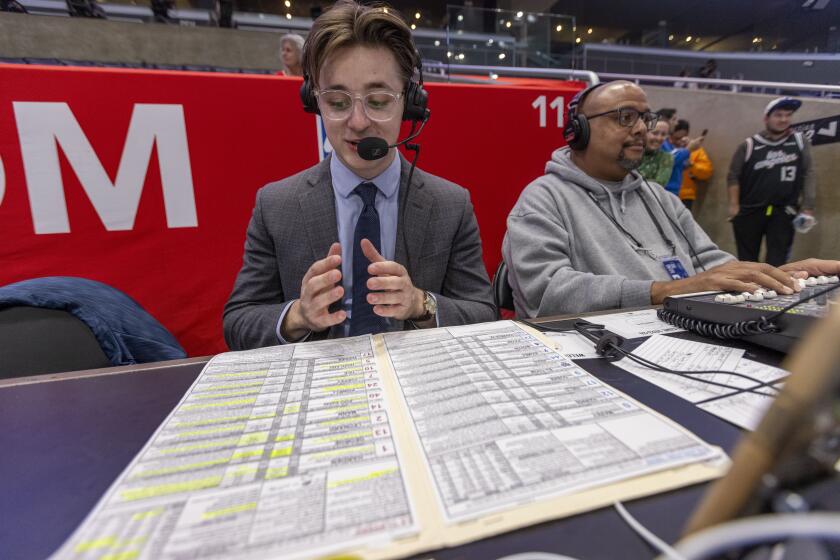‘Nomadic tribe’ of nice guys
One measure of the cultural tumble bowling has taken -- from its heyday as a beloved, popular sport to its mocked status as a pastime for the perpetually unhip -- can be seen in how the movies have portrayed it.
Documentary film producer Wilhelmus “Bill” Bryan remembers an earnest 1979 flick called “Dreamer” with Tim Matheson. “It’s about a guy who goes on the pro bowling tour, and he’s kind of like a Tom Cruise, a heartthrob. Cut to years later and you’ve got Woody Harrelson in ‘Kingpin,’ ” says Bryan, referring to the 1996 Farrelly brothers comedy that features sad comb-overs, beer bellies and unfortunate fashions. “Somehow the country shifted, and everything that was bad in white men, bowling got hit with.”
Now cut to “A League of Ordinary Gentlemen,” the documentary Bryan produced that’s opening Friday in Los Angeles, which chronicles the efforts of the Professional Bowler’s Assn. -- bought in 2000 by three former Microsoft executives -- to turn the sport’s fortunes around. Bryan and his filmmaking partners, brothers Alex and Chris Browne, saw movie potential in the Microsoft story. But they were also drawn to characters like Steve Miller, the ex-Nike marketing executive hired to be the PBA’s chief executive, and players like tour veteran Pete Weber, a guy with a “bad boy” reputation living in the shadow of his dad, the trophy-laden legend Dick Weber, who ruled the airwaves when bowling was a televised phenomenon on par with golf.
Then, Bryan recalled recently by phone, “around that same time,” Alex and Chris learned “their local bowling alley where they grew up having birthday parties was turned into a day spa.”
What struck the guys initially as they began documenting the tour was how open the players were, which Bryan attributes to the low-key nature of the game. “Bowlers will really give you a tremendous amount of access to their lives,” says Bryan, who uses the example of former top player Wayne Webb, seen in “League” laying bare his money problems, his worries that his best days are behind him, and thoughts of quitting. “I think it’s because they don’t really have locker rooms, they don’t have cameras, people doing interviews with them afterward. We were on virgin ground, almost. They’re very normal guys who are close to their fans and used to interacting with people.”
In the larger scheme of sports stardom, though, such down-to-earthness -- from the spare-tire physiques to the easily accessible arenas of play -- has likely been one of bowling’s problems. Says Bryan, “You just can’t play baseball at Yankee Stadium. There’s a real separation there between [baseball players and fans]. But I can go bowl on any of the lanes [the pros] are bowling on.”
Traveling with the players, in fact, pulled back the curtain on a particular view of America: an interchangeable topography of strip malls, fast-food joints, bars and bedroom communities. “You forget where you are,” says Bryan, who figures he and the crew logged 30,000 miles covering the tour from September 2002 to March 2003. “You’ll get in the car, drive 800 miles and just feel like you’re going back to where you were before. It was a strange feeling.” As for the bowlers themselves, “What’s interesting is that it’s like this nomadic tribe of guys,” he says. “You start to realize pretty quickly why [they] all get divorced.”
“These are real people,” says Miller, on the phone from Seattle. “And very identifiable. We all know them.” In the film, Miller comes off as the tough love motivator for the players, determined to wrench bowling from its marginalized, belittled standing with better ESPN coverage and endorsement deals, even if it means putting off tour regulars unused to thinking about their own sport in terms of “value” and “equity.” In one scene, the bulldog-like Miller gives the players a verbal going-over at a preseason meeting for what he perceives as a bad attitude toward his efforts at pumping up their image. It’s something one can’t imagine Tiger Woods enduring at a PGA confab, but then again, golf stars dominate golf.
Miller seems slightly embarrassed now by the aggression captured on camera, but believes he had to be harsh to uplift a group that “had been victimized for so long. We had to break some of that.” He says that when he first started as CEO, “I said to them, ‘I’ll know that we succeeded when you all become [jerks]. It’s a sad commentary on sports, but the truth is, when I can no longer speak to you, when I’ve got to talk to your agent, I’ll know the league is going in the right direction.’”
Although “League” has laughs, the filmmakers wanted to get stereotype giggles out of the way early. One coup for their efforts at sensitivity was securing Michael Moore’s longtime editor Kurt Engfehr, a dedicated league bowler. “We didn’t know a lot of the subtleties of the sport, and I think that comes across, having been edited by a guy who respects people who bowl,” says Bryan. “It doesn’t have that kitsch edge to it.”
What they and the PBA are hoping is that “League” plays like the 2003 doc hit “Spellbound”: The filmmakers want that movie’s audiences, and the association wants the greater visibility it gave a niche area of competition. And if people get a taste and appreciation for the professional, athletic side of what’s viewed as mostly a recreational indulgence, all the better.
“It’s all relative,” says Miller, who says his five-year plan for bowling is making headway with increased sponsorship and ratings. “Nobody said all baseball players are fat, but you see one bowler that’s overweight, or drinking beer until his face falls off, and you associate it with everyone. In golf they bring the bar to you. At least in bowling, you’ve got to walk from one place to the other.” He chuckles. “I try to take it in some stride.”
More to Read
Get our high school sports newsletter
Prep Rally is devoted to the SoCal high school sports experience, bringing you scores, stories and a behind-the-scenes look at what makes prep sports so popular.
You may occasionally receive promotional content from the Los Angeles Times.






